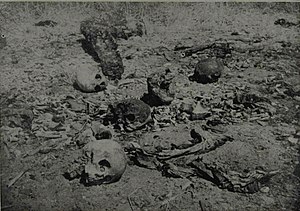| 1947 Rawalpindi massacres | |||
|---|---|---|---|
 Skeletal remains of people burned to death at Thamali during the Rawalpindi massacres | |||
| Date | March 1947 | ||
| Location | Rawalpindi Division, Punjab, British India | ||
| Caused by | Muslim mobs | ||
| Goals | |||
| Methods | |||
| Parties | |||
| |||
| Lead figures | |||
| Casualties | |||
| Death(s) | 2,000 – 7,000 | ||
The 1947 Rawalpindi massacres (also 1947 Rawalpindi riots) refer to widespread violence, massacres, and rapes of Hindus and Sikhs by Muslim mobs in the Rawalpindi Division of the Punjab Province of British India in March 1947. The violence preceded the partition of India and was instigated and perpetrated by the Muslim League National Guards—the militant wing of the Muslim League—as well as local cadres and politicians of the League, demobilised Muslim soldiers, local officials and policemen.[1][2] It followed the fall of a coalition government of the Punjab Unionists, Indian National Congress and Akali Dal, achieved through a six-week campaign by the Muslim League. The riots left between 2,000 and 7,000 Sikhs and Hindus dead, and set off their mass exodus from Rawalpindi Division.[3][4] 80,000 Sikhs and Hindus were estimated to have left the Division by the end of April.[5] The incidents were the first instance of partition-related violence in Punjab to show clear manifestations of ethnic cleansing,[6][7] and marked the beginning of systematic violence against women that accompanied the partition, seeing rampant sexual violence, rape, and forced conversions, with many women committing mass suicides along with their children, and many killed by their male relatives, for fear of abduction and rape.[8][9] The events are sometimes referred to as the Rape of Rawalpindi.[a]
- ^ Ahmed 2011, p. 685.
- ^ Hajari 2015, p. 108.
- ^ Ahmed 2011, pp. 221, 374.
- ^ Butalia 2000, p. 183.
- ^ Pandey 2001, p. 24.
- ^ Talbot 2019, p. 10.
- ^ Talbot & Singh 2009, p. 67.
- ^ Major 1995, p. 59.
- ^ Butalia 2013, p. 73.
- ^ Chandra, Prabodh Rape of Rawalpindi (1947)
- ^ Ahmed 2011, p. 221.
Cite error: There are <ref group=lower-alpha> tags or {{efn}} templates on this page, but the references will not show without a {{reflist|group=lower-alpha}} template or {{notelist}} template (see the help page).